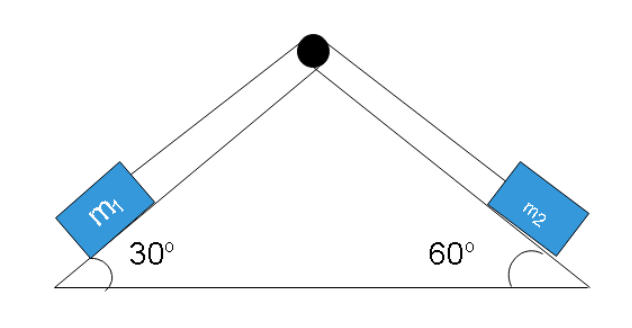
Given that ${m_1} = \,10\,kg$ and ${m_2} = 12\,kg$ connected as shown in the figure given below. Find tension in the string and acceleration of the two blocks.

Answer
218.7k+ views
Hint: In this solution, we will find the components of the blocks that will exert tension on the string i.e. parallel to the slope of the inclined plane. Both the blocks will have the same acceleration since they are connected with a string which will be under constant tension.
Complete step by step answer:
Looking at the figure, the block of mass 12 kg will be heavier and as a result, it will move downwards and at the same time, pull the block of mass 10 kg upwards. Both the block will have the same acceleration since they are tied by the same string under acceleration and hence the same tension in the string as well.
Since the block of mass 10 kg will be moving upwards, the pseudo acceleration force and the tension in the string will both be towards the pulley, parallel to the surface of the power and the component of the weight for the block will be downwards. So, we can write
\[{m_1}a = T - {m_1}g\sin {\theta _1}\]
\[ \Rightarrow T = {m_1}g\sin {\theta _1} + {m_1}a\]
Similarly, for the second block, we can write, the weight and the acceleration will be downwards
\[{m_2}a = {m_2}g\sin {\theta _2} - T\]
\[ \Rightarrow T = {m_2}g\sin {\theta _2} - {m_2}a\]
So comparing tension in both these equations, we can write
$\dfrac{1}{2}{m_1}g + {m_1}a = \dfrac{{\sqrt 3 }}{2}{m_2}g - {m_2}a$
Solving for $a$, we get
$22a = \dfrac{{\sqrt 3 }}{2}(12)g - \dfrac{1}{2}(10)g$
On substituting $g = 10\,m/{s^2}$, we get
$22a = 54$
Hence $a = 2.45\,m/{s^2}$
Then the tension in the string can be calculated as
\[T = {m_1}g\sin {\theta _1} + {m_1}a\]
\[ \Rightarrow T = 50 + 24.5\]
Hence the tension in the string will be
$T = 74.5\,N$
Note: Here we have assumed that there is no friction acting on the blocks and the ramps which can hinder the motion of the blocks. Since the second block is heavier and also at a more inclined plane, we can assume that it will be pulling the first block.
Complete step by step answer:
Looking at the figure, the block of mass 12 kg will be heavier and as a result, it will move downwards and at the same time, pull the block of mass 10 kg upwards. Both the block will have the same acceleration since they are tied by the same string under acceleration and hence the same tension in the string as well.
Since the block of mass 10 kg will be moving upwards, the pseudo acceleration force and the tension in the string will both be towards the pulley, parallel to the surface of the power and the component of the weight for the block will be downwards. So, we can write
\[{m_1}a = T - {m_1}g\sin {\theta _1}\]
\[ \Rightarrow T = {m_1}g\sin {\theta _1} + {m_1}a\]
Similarly, for the second block, we can write, the weight and the acceleration will be downwards
\[{m_2}a = {m_2}g\sin {\theta _2} - T\]
\[ \Rightarrow T = {m_2}g\sin {\theta _2} - {m_2}a\]
So comparing tension in both these equations, we can write
$\dfrac{1}{2}{m_1}g + {m_1}a = \dfrac{{\sqrt 3 }}{2}{m_2}g - {m_2}a$
Solving for $a$, we get
$22a = \dfrac{{\sqrt 3 }}{2}(12)g - \dfrac{1}{2}(10)g$
On substituting $g = 10\,m/{s^2}$, we get
$22a = 54$
Hence $a = 2.45\,m/{s^2}$
Then the tension in the string can be calculated as
\[T = {m_1}g\sin {\theta _1} + {m_1}a\]
\[ \Rightarrow T = 50 + 24.5\]
Hence the tension in the string will be
$T = 74.5\,N$
Note: Here we have assumed that there is no friction acting on the blocks and the ramps which can hinder the motion of the blocks. Since the second block is heavier and also at a more inclined plane, we can assume that it will be pulling the first block.
Recently Updated Pages
Two discs which are rotating about their respective class 11 physics JEE_Main

A ladder rests against a frictionless vertical wall class 11 physics JEE_Main

Two simple pendulums of lengths 1 m and 16 m respectively class 11 physics JEE_Main

The slopes of isothermal and adiabatic curves are related class 11 physics JEE_Main

A trolly falling freely on an inclined plane as shown class 11 physics JEE_Main

The masses M1 and M2M2 M1 are released from rest Using class 11 physics JEE_Main

Trending doubts
JEE Main 2026: Application Form Open, Exam Dates, Syllabus, Eligibility & Question Papers

Derivation of Equation of Trajectory Explained for Students

Hybridisation in Chemistry – Concept, Types & Applications

Understanding the Angle of Deviation in a Prism

Understanding Collisions: Types and Examples for Students

Understanding Atomic Structure for Beginners

Other Pages
JEE Advanced Marks vs Ranks 2025: Understanding Category-wise Qualifying Marks and Previous Year Cut-offs

Units And Measurements Class 11 Physics Chapter 1 CBSE Notes - 2025-26

NCERT Solutions For Class 11 Physics Chapter 8 Mechanical Properties Of Solids

Motion in a Straight Line Class 11 Physics Chapter 2 CBSE Notes - 2025-26

NCERT Solutions for Class 11 Physics Chapter 7 Gravitation 2025-26

How to Convert a Galvanometer into an Ammeter or Voltmeter




